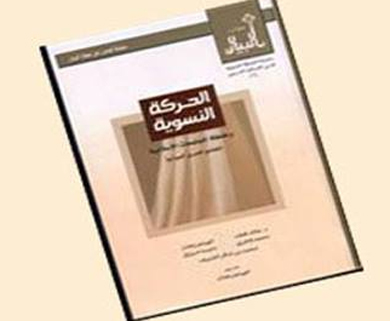Book Review: Is Islamic feminism a movement?
By Mahmoud El-Wardani
30 Mar 2015

Al-Haraka Al-Nasaweyya Al-Islamiyya fi Misr (The Islamic Feminist Movement in Egypt) by Sawsen El-Sharif, Rawafid Publishing, Cairo, 2015. pp.199.
Since Islamic feminism is still in the embryonic stage, it is difficult for researchers to call it a "movement" that has an actual existence in reality, or an activity like the rest of the democratic feminist movement's currents in Egypt.
This is the case to the extent that, according to the author Dr. Sawsen El-Sharif, any female researcher who tackles this issue writes her papers and research in English then translates them into Arabic. This explains the spelling and grammatical mistakes in addition to the editing mistakes in her first book about Islamic feminism.
As El-Sharif makes clear in her introduction, the book is a result of a study that focused on human rights issues, particularly personal status laws. It was motivated by the controversy that erupted around the abrogation and amendment of some laws in the light of practices that mix up the Islamic sharia law with cultural and social traditions.
The book is comprised of four chapters; the first presents an analytical critique of this elitist current. El-Sharif explains that Islamic feminism searches in religious texts, the Quran, the prohet's sayings and in Islamic fiqh(jurisprudence) with the purpose of presenting new readings and interpretations of some matters regarding women.
To quote the author, it "seeks to purify the teachings of Islam which Allah wanted to be free of social impurities and cultural traditions."
On another level, what's really astonishing is that most of the writings regarding this topic are written by Islamic feminists in the West or in Asia, in countries such as Iran, Turkey, Indonesia and the USA. As for Egypt, the majority of what has been written was in English, because the objective was initially to counter voices that don't know Islam well outside Egypt.
Indeed, some forms of Islamic feminism foundations were established abroad such as "Sisters in Islam", "Karama" ('Dignity' in Arabic) and "Musawah ('Equality' in Arabic) Movement" in Malaysia, alongside some research centres.
As for Egypt, the Women and Memory Forum is the first working institutional attempt to do the same and it supports the fundamentals of Islamic feminist activism, including by documenting women's experiences. It has actually published a limited number of books and publications that document the history of women who have contributed in a way or another in the advancement of the women's movement.
The author states that the emergence of the feminist movement – as an independent approach – isn't Egyptian and most of the Egyptian Islamic feminists were influenced by the world's pioneers of this movement from the USA or Iran for instance.
In the second chapter, El-Sharif discusses the concept and practice of Islamic feminism. She asserts that the religion – contrary to what is commonly believed – isn't a source of discrimination against women. Her proof is that Western women are discriminated against despite the fact that Western countries have been secularized and broken free of religious ideas that were the source of persecution.
Thus, the problem lies in the hegemonic masculinity through which the religious texts are interpreted and applied. Islamic feminism sees that the spiritual message of Islam was obliterated and the male, patriarchal system transformed the equality which Islam as a religion was calling for, into a tool for discriminating against women.
The third chapter is devoted by the author to discussing the relationship between the movement and Islamicfiqh. El-Sharif argues that Islamist feminists perceive these Islamic jurisprudential opinions as affected to a great extent by the social and cultural context which they grew out of.
The author deals in the fourth chapter with the four of the most contentious issues among members of the movement, namely; dowries, marriage certificates, guardianship, and the marital relationship. She has chosen these issues because she considers them pivotal issues. In this context, the movement demands new Islamic jurisprudential interpretations of these items because those interpretations that have been deployed within the tradition of fiqh reflect a male, patriarchal outlook that overlooks women's rights, despite the fact that Islam honoured women and put them in a highly esteemed position.
El-Sharif concludes her book by evaluating the Islamic feminist movement and admits that feminist writings aren't particularly accessible, and are full of complex and unusual linguistic formulations that prevent ordinary readers from following the material.
Although the movement defends women rights, it hasn't managed to successfully reach out to all of society's segments. Its activities are almost exclusively concerned with research, studies and working papers which are to be presented at academic conferences.
It is quite obvious that this current, which is affiliated with the Islamic point of reference, has fallen into the trap of the contradiction between the language that its members use to express themselves with and the need to reach out to wider society, including ordinary people and institutions. Having said that, the movement is still in its early stages and it is therefore premature to make any judgements about the extent of its reach and impact
Source: http://english.ahram.org.eg/NewsContent/18/62/123900/Books/Review/Book-Review-Is-Islamic-feminism-a-movement.aspx

No comments:
Post a Comment